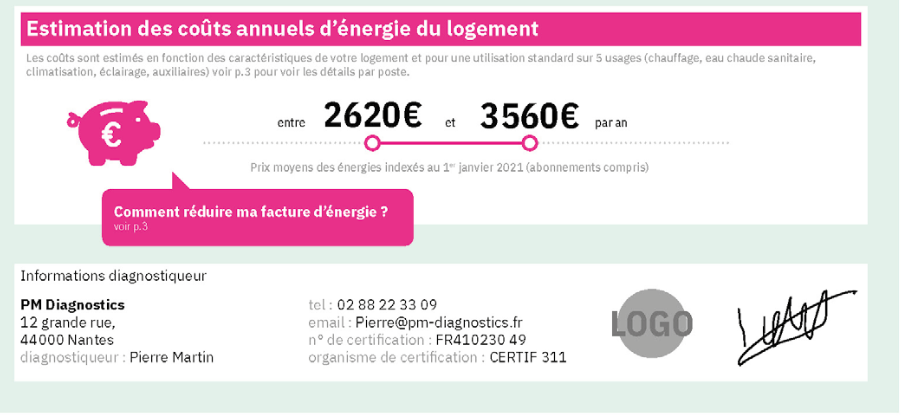Selling a Luxury Property with a Bad DPE: Challenges and Solutions
The Energy Performance Diagnosis (EPD) has become an essential criterion in the sale of real estate, including luxury properties. While most buyers in this segment are primarily looking for aesthetic criteria and high-end services, energy performance can impact the purchasing decision, especially since the emphasis on energy transition and environmental regulations.
Selling a luxury property with a poor DPE can pose several challenges, but that does not mean the sale is compromised. This article explores the implications of a poor DPE, the impacts on price and the strategies to adopt to successfully sell despite this constraint.
What is a Bad DPE?
The DPE assesses the energy consumption of a building and its impact in terms of greenhouse gas emissions. It is classified from A (high performance) to G (poor performance). A poor DPE, usually rated E, F or G , means the property is energy-intensive and environmentally unfriendly.
In a context where ecological standards are increasingly strict, a poor DPE can have certain consequences on the value and attractiveness of the property.
Impacts of a Bad DPE on the Sale of a Luxury Property
1. Reduction in Property Value
A poor DPE can result in a reduction in the selling price. Indeed, potential buyers take into account future energy renovation costs to improve the performance of the property. In some cases, this may represent costly work which will be negotiated in the purchase price.
2. Restricted access to certain financing
Banks and lending institutions may be more reluctant to finance energy-inefficient properties, or they may impose stricter conditions. This can reduce the number of potential buyers.
3. Loss of attractiveness for foreign buyers
In luxury real estate, a large proportion of buyers are international. The latter, often sensitive to environmental issues, could be less inclined to buy a property with a poor DPE, especially in a market where sustainability is becoming an increasingly popular criterion.
4. Binding regulations
, ultimately, the sale of properties classified F or G. Although these measures mainly concern rental properties, they can also impact the attractiveness of your luxury property.
Strategies for Selling a Luxury Property with a Bad DPE
1. Highlight the Assets of Good
Even with a poor DPE, a luxury property can have exceptional assets that compensate for its energy inefficiency. Highlight:
- The premium location , whether by the sea, in the historic city center or in a sought-after area.
- High-end services , such as a swimming pool, a spa, a landscaped garden, a cinema room or luxury finishes.
- The unique history or architecture of the property (castle, historic villa, listed building).
- The panoramic view or the vast interior spaces which are essential criteria for buyers in this segment.
2. Propose Energy Renovation Solutions
Anticipate buyers' concerns by presenting them with concrete solutions for improving energy performance. This could include:
- Quotes for work for insulation, replacement of windows, or the installation of more efficient heating systems (heat pump, condensing boiler).
- Estimates of the cost of the work and the duration of the construction sites.
- Information on financial aid and subsidies available, such as energy renovation bonuses .
This reassures potential buyers and allows them to have a clearer vision of possible improvements.
3. Offer a Price Negotiation
A bad DPE can be a starting point for a negotiation. Rather than seeing this as a disadvantage, this can be an opportunity to offer a discount on the sale price, or to offer concessions such as partial coverage of energy renovation costs.
4. Targeting an Audience Less Sensitive to Energy Issues
In luxury real estate, some buyers are primarily motivated by the prestige and unique character of the property. This public may be less attentive to energy performance, especially if the property is rare and offers exceptional characteristics (location, design, history). In this case, the focus should be on the emotional and experiential of ownership.
5. Valuing Long-Term Investment
Even with a poor DPE, a well-located luxury property remains a long-term investment . Explain to your clients that the potential added value on this type of property, especially if it is rare, often compensates for any short-term energy renovation work.
Preventing Future Difficulties
If you have a luxury property with a poor DPE, it may be wise to invest in an energy improvement before putting it up for sale . This could include:
- Wall and roof insulation
- Replacing old heating systems
- Installation of solar panels or geothermal systems
These investments will not only increase the value of the property , but they will also facilitate the sale by avoiding the constraint of a bad energy label.
Conclusion
Selling a luxury property with a poor DPE presents some challenges, but they are not insurmountable. By highlighting the unique assets of the property, offering concrete solutions to buyers, and adapting your sales strategy, it is entirely possible to conclude a successful transaction. As the luxury market is often motivated by rarity and prestige, energy performance, although important, is only one of the many factors to take into account when selling this type of property.
Follow “ ProprietesDeCharme.com ” on YouTube but also on Facebook Twitter LinkedIn Instagram Pinterest



